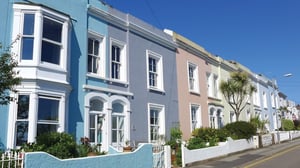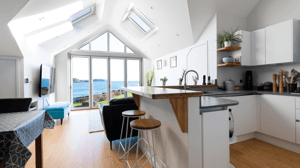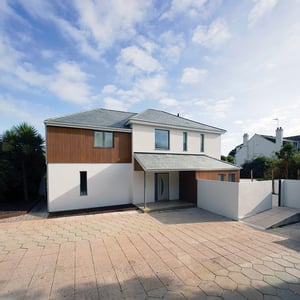
Architects in Falmouth
Thoughtful, modern architecture for life in our home town
Our connection to Falmouth
Ready to start your building project in Falmouth?
Get in touch to tell us about it and let us help you create your story of space.

We are bringing modern, sustainable design to Cornwall’s coastline
Sustainability isn’t an add-on for us, it’s woven into every stage of the design process.
From the moment we explore your brief, we look for ways to reduce energy use, improve long-term performance and make the most of natural light, ventilation and orientation.
We consider low-impact materials, smart insulation strategies and future-proof heating solutions, balancing environmental responsibility with comfort and practicality.
The result is a space that not only feels better to live in, but one that stands the test of time with a lighter footprint on the Cornish landscape.
Our architectural services in Falmouth
Residential architecture
Your home should feel effortless. Calm. Functional. Personal. As specialist residential architects in Falmouth, we design spaces that enhance daily life, we cover projects from family homes and coastal retreats to contemporary new builds.
Our residential work covers but not limited to:
- New builds
- Extensions & renovations
- Coastal property design
- Loft and interior reconfigurations
- Sustainable upgrades & low-energy design
Commercial and community projects
Falmouth is a town filled with energy and opportunity. We can help businesses and community groups turn that energy into purposeful spaces.
We work across:
- Retail & hospitality
- Offices & co-working
- Workshops & light industrial
- Community buildings
- Regeneration projects
Planning and design
Navigating planning can feel overwhelming, but it doesn’t have to. Our team handles the entire planning and design journey, ensuring your project is clear, compliant and ready for approval.
We provide:
- Feasibility studies
- Planning applications
- Building regulations drawings
- Full technical design packages
- 3D walkthroughs for unmatched clarity

We are passionate about being part of beautiful projects
“Highly recommended. Marraum helped us convert our old fashioned tiny 2 bedroom terraced house by the sea, into a stunning, contemporary and spacious home. They have an incredible eye for space and could see that with minimal extension and a reconfiguration, we could maximise the space, and the views! We are thrilled with the result. We would never have thought it possible to achieve everything they managed to accommodate in a relatively small space, and they rose to every challenge we set them. In addition to this, they were absolutely lovely to work with. We would certainly use them for any future projects..”
Elinor C
“We can't recommend Marraum highly enough. Adam and his team took great care in exploring and understanding our vision for extending and remodelling our coastal home. The resulting plans are beautiful aesthetically and perfectly suited to how we will live in the house. We were guided through what can be a complicated process with professionalism and efficiency every step of the way. We are now ready to start the building works and can't wait to live in our new home.”
Harriet C
“New to the area and not knowing who to turn to for my full renovation project i signed up to a local company unknown to me, Marraum. From the first review meeting i knew that i'd made a good choice. I found the team at Marruam to very professional, knowledgeable, helpful, enthusiastic, dynamic and creative, and it was clear they had a real interest and passion for there job, and a personal interest to each project. They went above my expectations and helped in every aspect of my renovation project, from concepts and designs, structural requirements, and to planning & building control. They even pointed me in the direction of good local trade-persons to undertake the project. I would highly recommend the team at Marruam, and would without doubt use them for any future projects i undertake.”
Tom Y

That is why we are rated one of the best architects in Falmouth
Design that puts people first
We start with how you want to live or work, then we design backwards from that point.
Total clarity through 3D technology
Our immersive 3D modelling lets you walk through your future space before a brick is laid.
Planning confidence
With years of experience in Cornwall, we understand the local landscape, policies and constraints.
Sustainable thinking, built in
Every design considers longevity, performance and impact.
A collaborative, transparent process
We’re here to make the journey smoother, simpler and genuinely enjoyable.
Let us create something beautiful together in Falmouth
Our team is here to guide you from the first sketch to the final build. Get in touch today and let’s start shaping a home that feels beautifully designed around you.

Frequently asked questions
Costs vary depending on your project’s size and complexity, but we offer clear, transparent pricing from the outset. After an initial conversation and understanding your brief, we’ll provide a detailed, fixed-fee proposal so you know exactly what to expect.
Yes, we’re happy to collaborate with your chosen builder. We can also recommend trusted contractors we’ve worked with before, ensuring your project runs smoothly from design to build.
Absolutely. We specialise in using immersive 3D modelling to let you explore your space before any construction begins. It’s one of the best ways to gain confidence and clarity early on.
Yes. We take care of both planning applications and the technical drawings required for building regulations approval, so everything is coordinated and consistent.
Timelines depend on the scope of the work, a small extension might take a ten months to get on site, while a full new build could take over a year We’ll outline each stage clearly so you always know what’s happening next.
Yes. From compact extensions to full home reconfigurations, we work across projects of all sizes as long as we can deliver meaningful design value.
Definitely. Sustainable upgrades can be integrated into almost any home, including traditional Cornish properties. We’ll advise on the most effective improvements without compromising character.




